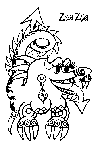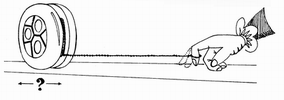Extract
6pp
|
OzNAKI References
An annotated List including precursor publications on Qualitative Physics and Mathematical Epistemology related microprocessor sofware development. and the La Talking Communicator |
| Papers on Cognition and Mathematical Education | |
|
| From circa 1972, a Quiz on Qualitative Physics for u/g students of mechanics devised by HAC. This was the start of active research, which involved the development of dragons - simple qualitative puzzles in elementary physics -- that both the expert and the tyro could answer with confidence, but with remarkably different solutions. See the web page Dragons. |
|
Extract 6pp |
|
|
| H.A. Cohen, Mathematical Dragon Hunting on the La Trobe Campus, Australian Vice-Chancellor"s Committee (AVCC) Educational Newsletter, 3/73, January 1974. To stimulate the intellectual growth of students a new style of student exercise, the Dragon, has been devised and utilised in a course in applied mathematics at La Trobe University. |
| Anti-maths syndrome under attack Published in the La Trobe University Record, Vol 9 No 7, December 1975. Summary of of objectives of the OZNAKI Project, written up by (journalist) Ernest Raetz from material supplied by Dr Harvey Cohen. | |
| H.A. Cohen, with illustrations by Jeni Rawson, A Dragon Hunter's Box, Hanging Lake Books, Melbourne, 1974. { A componendium of qualitative problems in dynamics } A few images from this publication [ officially determined to be not a book, and therefore ineligible for government print subsidy ] are here. Incorporates a number of dragons from What G Killed Ned Kelly? which are reproduced online there | |
| My MIT Artificial Intelligence Laboratory Memo | |
| H.A. Cohen, The Art of Snaring Dragons, M.I.T. Artificial Intelligence Laboratory Memo Number 338, May 1975. Dragons are formidable problems. challenging, and yet solvable using little or even no algebra or calculus. Dragons are also distinguished by the fact that (unlike other physics problems seen by the tyro as "difficult") both the tyro - and the experienced physicist, are confident with their - so-different - predictions. Thus such Dragons are akin to the Conservation Puzzles of Piaget, where both the four-year old pre-conserver, and the six year conserver are equally confident with their (differing!) conclusions. In this paper, written when the writer was part of the LOGO Group at the MIT Artificial Intelligence Laboratory, an explanation is given in terms of the Frames concept of Marvin Minsky. | |
| OZNAKI and related publications in chronological order | |
| H.A. Cohen, OZNAKI, in Set Two, published by Mathematics Association of Victoria, Melbourne, 1976, pp 36-39. | |
| H.A. Cohen, The OZNAKI Robotics Language OZ,
Proceedings of the 7th Australian Computer Conference, Vol. 1,
Aug 31- Sept 3, 1976, pp 128-143.
For page 1 of this paper Click here For page 16 of this paper Click here | |
| H.A. Cohen and D. G. Green, Teaching Mathematics with OZ-Graphics, Peoples Computers, 1977, vol 6 (3), pp 52-58. | |
| H.A. Cohen, Micro-Computers for Mini-Mathematicians, in L. Murray (Editor), Meaningful Mathematics, Published by the Mathematics Association of Victoria, 1977, pp 391-7. | |
| H.A. Cohen, Graphics on the Poly-88, Dr Dobb's Journal of Computer Calisthenics and Orthodontia, Published by the People"s Computer Company, Menlo Park, California, Vol. 2, No. 3, 1977, pp 12-13. | |
|
| H.A. Cohen, OZNAKI: A New Medium for Mathematicians, in D. Williams (Editor), Learning and Applying Mathematics , Published by the Australian Association of Mathematics Teachers, 1978, pp 274-83. |
| H.A. Cohen, The OZNAKI Life: Introducing the NAKI Concept for TV Graphics, Dr Dobb's Journal of Computer Calisthenics and Orthodontia, Published by People's Computer Company, Menlo Park, California, Vol. 3, No. 4, (1978) pp 10-11. | |
| H.A. Cohen and D. G. Green, Evaluation of the Cognitive Goals of OZNAKI: Enhancement of Spatial Projective Abilities, in A.M. Wildberger and R. G. Montanelli, (Editors), "ACM Topics in Instructional Computing," ACM Special Interest Group Computers in Education, SIGCUE, New York, 1978, pp 69-90. BibTeX | |
| H.A. Cohen, OZNAKI and BEYOND, in D. Harris (Editor), Proceedings of National Education Computing Conference, NECC "79 The University of Iowa, Iowa, June 1979, pp 170-178. | |
|
| H.A. Cohen, Expanding the Child's Concept of Number, Space and Operation, in M. Poole (Editor), From Creativity to Curriculum, Allen and Unwin, Sydney, 1980, pp 147-162. : BibTeX |
| H.A. Cohen, ESCHER: A Block-Oriented Graphics Language for Microcomputers, Proceedings of the National Microcomputer Conference on Personal Computing for the Eighties, ACS SIG, Canberra, 1980, pp 14.1-14.8 | |
| LOGO-84 [2] | |
| H.A. Cohen, Introducing LOGO-84: An Australian LOGO, in J.Hughes (Editor), Computers and Education: Dreams and Reality (Proceedings of the Second Australian Computer Education Conference, Sydney, 1984), Computer Education Group of N.S.W., pp 73-77. | |
| H.A. Cohen, LOGO-84: An Australian LOGO, in A.D. Salvas (Editor), in Computing and Education - 1984 and Beyond, (Proceedings of the Sixth Annual Conference of the C.E.G.V.), Computer Education Group of Victoria, Melbourne, 1984 pp 314-317. | |
| The La Trobe Talking Communicator for severely disbled speechless | |
| H.A. Cohen, Interfacing the Severely Handicapped to the Computer and the Computer to the Severely Handicapped: Design Principles of the La Trobe Talking Communicator, Conference Proceedings, TAD Computer Interface Seminar, Technical Aid to the Disabled, 1982. | |
| H.A. Cohen, Computer Communication, Access, and Programming by Severely Handicapped Children, in J.R. O"Leary and J.R. O'Reagan, Editors, Proceedings of the Fifth Annual Conference on Rehabilitation Engineering, Rehabilitation Engineering Society of North America (RESNA), Bethesda, Maryland, 1982, pp 41-45. | |
|
| H.A. Cohen, The La Trobe Talking Communicator for the Severely Disabled Speechless, in A.H. Sale and G. Hawthorne, Editors, Proceedings of the Ninth Australian Computer Conference, Hobart, Australian Computer Society, Hobart, Vol 1 pp 266-275 (1982) BibTeX |
|
| H.A. Cohen and J. Monro, Computer Communication, Access and Programming by Severely Handicapped Non-Speech Children, in R. Welch, Editor, Ninth Australian Computer Conference Schools Symposium 1982, Australian Computer Society, Hobart, pp 237-253 (1982) BibTeX |
| H.A. Cohen, The development of a TALKING COMMUNICATOR for the disabled Speechless, Conference Digest, 21st Conference on Physical Science and Engineering in Medicine and Biology, [organised by the Australian College of Physical Scientists in Medicine and other learned societies], School of Medicine, University of Melbourne, August 1981, pp K7. | |
| H.A. Cohen, Communication With By and To Computers: The Potential for Special Education, Conference Digest, Sixth National Conference, Australian Association of Special Education, Mannix College, Monash University, August 1981, pp 7-8. (Abstract only) | |
| Microprocessor Software Development [5] | |
| H.A. Cohen and R.S. Francis, Macro-Assemblers and Macro-Based Languages in Micro-processor Software Development, in P. Isaacson (Editor), Microprocessors and Microcomputers, IEEE Computer Society, New York, 1979, 2nd Revised Edition, pp 199-210. BibTeX | |
| H.A. Cohen and R.S. Francis, Macro-Assemblers and Macro-Based Languages in Microprocessor Software Development, IEEE Computer, Vol 12, No 2, Feb 1979, pp 53-64. BibTeX | |
| H.A. Cohen, Microprocessor Software Development Using Macroprocessors, in Proceedings of 8th Conference of the Australian Computer Society, Canberra, August 1978, Vol. 1, pp 148-164. | |
| H.A. Cohen and R. S. Francis, HELP for Microprocessor Software Development, IEEE Compcon Fall Conference Digest, Washington, September 1977, pp 196-200. | |
|
| Harvey A. Cohen and Rhys S. Francis, A Design Strategy for Micoprocessor Software Institute Radio and Electrical Engineers IREECON, Conference Digest, Melbourne August 1977, pp 119-121. |
| On Introducing Computer Concepts in Schools [2] | |
| H.A. Cohen, Making Algebra Concrete using a Microcomputer: An Algebraic Programming Language for the Control of Robots, in P. Williamson (Editor), Learn to Love Mathematics, Mathematics Association of Victoria, Melbourne, 1980, pp 336-350. | |
|
| H.A. Cohen, Modelling Boolean Algebra with Tinkertoy or Meccano: How to Construct a NIM Playing Machine, in P.Williamson (Editor), Learn to Love Mathematics, Mathematics Association of Victoria, Melbourne, 1980, pp 253-265.
Colour images relating to this paper and further construction details are here |
| Microcomputer Graphics [2] | |
| H.A. Cohen, ESCHER: A Block-Oriented Graphics Language for Microcomputers, Proceedings of the National Microcomputer Conference on Personal Computing for the Eighties, ACS SIG, Canberra, 1980, pp 14.1-14.8 | |
| H.A. Cohen, Graphics on the Poly-88, Dr Dobb's Journal of Computer Calisthenics and Orthodontia, Published by the People"s Computer Company, Menlo Park, California, Vol. 2, No. 3, 1977, pp 12-13. | |
|
| |
|
| Publications Since 89 By Year
This is a collection of papers in image engineering and visual information systems, including image processing generally including numberplate recognition and speed-up issues, image restoration, (IFS and) fractal image coding, issues in image retrieval using thumbnails, and parallel processing techniques, together with some papers devoted to the design of image codecs, to aspects of satellite systems and to the education of engineers. |
|
|
Publications Prior to 89 By Topic excluding Physics Papers
These papers are grouped by topic. Topic titles include qualitative physics, mathematics education, OZNAKI - a pioneering educational robotics project, the La Trobe Talking Communicator ( developed for severely disabled non-speech students ). |
|
|
Papers on Physics and Geophysics
This directory of papers in theoretical particle physics and quantum electrodynamics includes the abstracts for each paper. |
|
|
Primers on VIS and Image Engineering
VIS = Visual Information Systems.Topics: Edges. Interesting points. Image restoration. Image access via thumbnails. Texture analysis, identification, segmentation. Fuzzy image processing. Using fractals to encode images. The perceptron images. |

|
 Dragons are formidable problems in qualitative physics,
challenging, and yet solvable using little or even no algebra or calculus.
Dragons are formidable problems in qualitative physics,
challenging, and yet solvable using little or even no algebra or calculus.e.g. Which direction does the yo-yo roll? What if the table were greased? Buy a yoyo to check !! are you a Newtonian ? |
|
| Personal Home Page of Dr Harvey A. Cohen of Melbourne Australia |